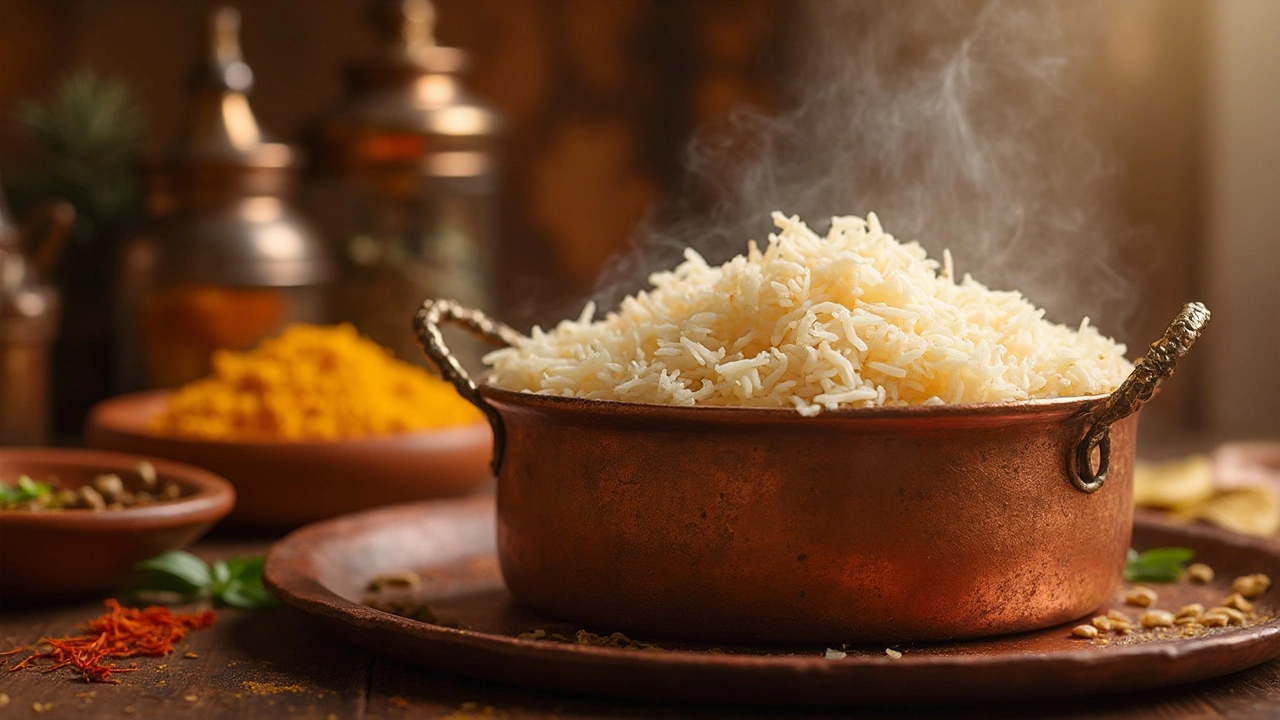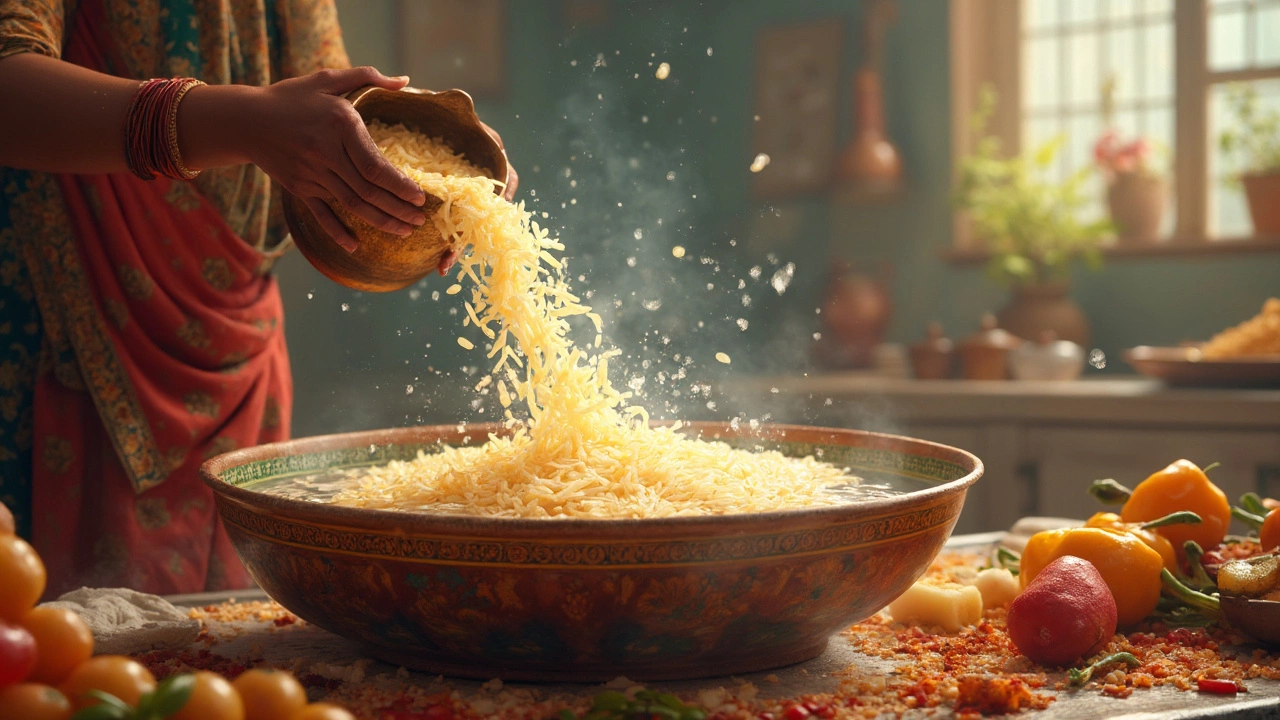Why Soaking Rice is Key for Perfect Biryani
 Apr, 16 2025
Apr, 16 2025
Alright, let's get down to brass tacks here. You see, soaking rice for biryani isn't just some ancient tradition your grandmother handed down. It's a game-changer in the world of cooking. Imagine trying to cook biryani, and the rice turns out mushy or clumps together. Not what you had in mind for dinner, right?
Soaking rice for about 30 minutes before cooking helps the grains absorb water, which makes them swell up. This simple act reduces the cooking time and ensures that each grain stays separate and fluffy, giving your biryani that perfect texture.
- The Science Behind Soaking
- Benefits of Soaking Rice
- How Long to Soak Rice for Biryani
- Common Mistakes and Tips
The Science Behind Soaking
Let’s break down what's really happening when you soak that basmati rice. Think of rice grains as tiny sponges. When you expose them to water before cooking, they start to absorb it, which is crucial for even cooking later on. You don't want some parts cooked more than others, right?
When rice absorbs water during soaking, it starts the hydration process without heat. The grains swell as they absorb moisture, reducing the time and energy needed to cook them thoroughly. Soaking rice helps to wash away excess starch too. You know that cloudy water when you rinse rice? That's the starch that makes your rice sticky—goodbye to that when you soak!
Another thing to think about is cooking consistency. Think of each grain doing its little dance in the pot, cooking evenly without giving you a surprise clump now and then. Soaked rice tends to cook more uniformly, ensuring those grains stay in separate lanes and don't turn into one big mushy pile.
By starting with properly soaked rice, you’re not just saving cooking time; you're also making sure that perfect, fragrant biryani aroma comes through, with rice that looks as good as it smells. And that’s the beauty behind the science!
Benefits of Soaking Rice
Soaking rice before cooking isn't just for show—it's got legit perks, especially when it comes to making the perfect biryani. Let’s break this down so you can impress friends and family with more than just some amazing cooking tips.
First off, soaking rice helps in achieving that ideal fluffy texture. Basmati rice, the king of rice varieties for biryani, is naturally aromatic but can be tricky to cook. When soaked, the rice grains absorb water, reducing the time it takes to cook them. This means you get perfectly cooked rice that doesn't stick together. No more mushy disasters!
By soaking, you're also making sure that the rice cooks evenly. Each grain starts on the same playing field, having absorbed a bit of water. This way, when the heat's turned up, they all respond the same way, ensuring consistency in every spoonful of biryani.
Here's something that not everyone knows: soaking rice can reduce some of the starch. Why's that important? Less starch means the rice doesn't clump and you get to enjoy that separate grain experience everyone raves about when talking about great biryanis.
To top it off, soaking enhances the grain length. It’s not just about taste and texture; it's about presentation too. A good quality biryani with long, fluffy rice grains is both a treat to the taste buds and the eyes.
- Fluffy texture
- Even cooking
- Less starch equals lesser clumping
- Improved grain length

How Long to Soak Rice for Biryani
You might be wondering, how long should you soak rice for your biryani to get that perfect fluffiness? The typical sweet spot is about 20 to 30 minutes. This is enough time for the rice grains to absorb just the right amount of water without getting too soft.
Why this time frame? Well, it's all about getting the right balance. Soaking your rice for around half an hour allows it to start cooking even before it hits the pot. The water begins to soften the grains, ensuring they cook evenly, which is especially important for keeping basmati rice, a favorite for biryani, long and separate.
If you're rushing, you might think about cutting this step short. But trust me, skipping or shortening the soak means risking sticky or unevenly cooked rice, and nobody wants that mixed with their biryani delight. If you ask seasoned cooks, soaking is just as crucial as the spices you add.
Here's a little pro tip: if you're using older rice (like over a year old), it might need a bit more time to soak properly. But generally, stick to that 20 to 30-minute mark as your baseline for success.
Common Mistakes and Tips
Soaking rice might sound straightforward, but a few slip-ups can throw a wrench in the works. If you've ever wondered why your biryani isn't the masterpiece you hoped for, you might be making one of these common mistakes.
First, using the wrong amount of water when soaking is a biggie. You want enough water to completely cover the rice, so it can expand well. If there's too little water, the rice won't soak evenly, leaving you with some crunchy bits mixed in with a mushy mess.
Another pitfall is not timing the soak right. While a 30-minute soak works for most rice varieties, basmati can get away with 20 minutes. More than that, and the grains might absorb too much water, turning them sticky. Always set a timer.
Imagine draining the soaked rice using a muslin cloth—without breaking the grains. Over enthusiastic rinsing or stirring is a common mistake that can crush the delicate grains of rice, which is a no-go for any biryani lover.
Now for some practical tips:
- Make sure you rinse the rice until the water runs clear before soaking. This helps remove excess starch.
- Invest in high-quality basmati rice. It makes a world of difference.
- To elevate the flavor, add a bay leaf or two in the soaking water.
And here's a little pro-tip: keep an eye on the cooking ratio. For perfectly cooked biryani, aim for a rice-to-water ratio of 1:1.5 when cooking, post-soak. If you're soaking rice for the first time, jot down these tips, and you'll nail the biryani every time!
